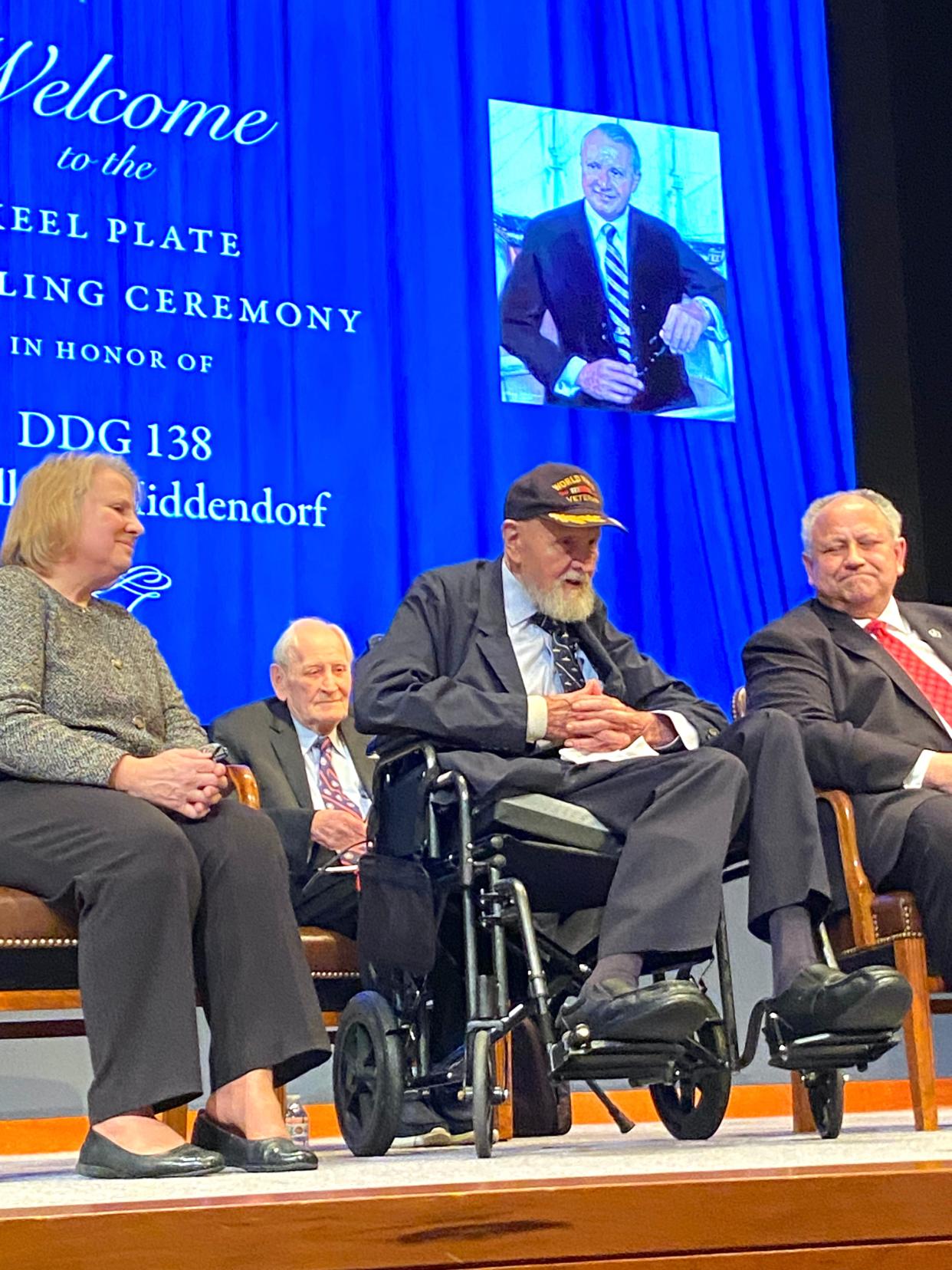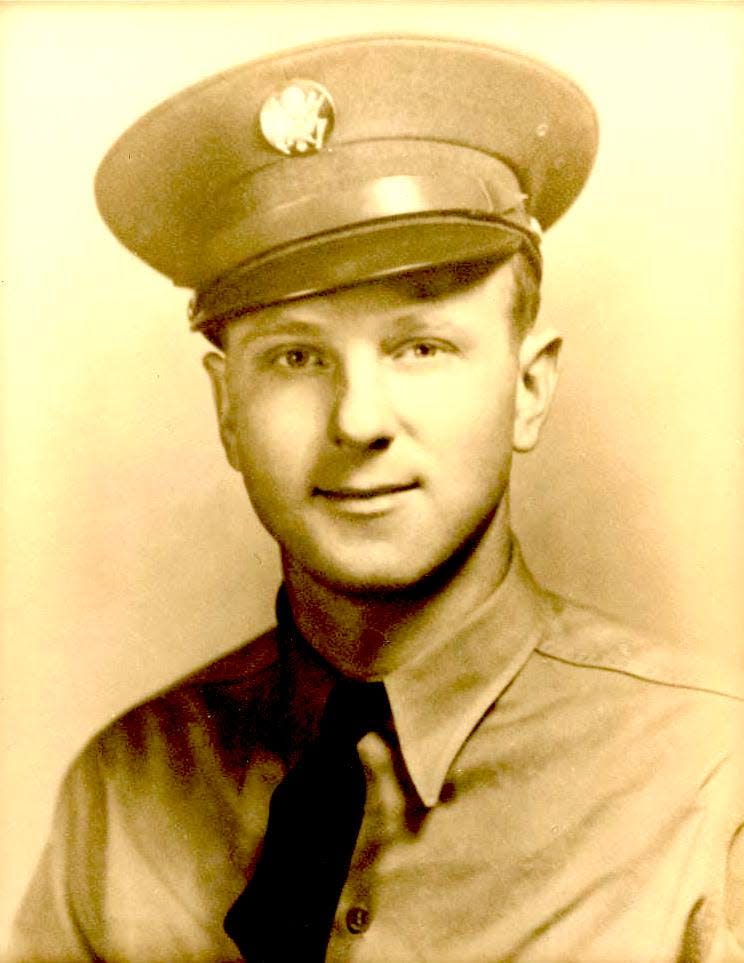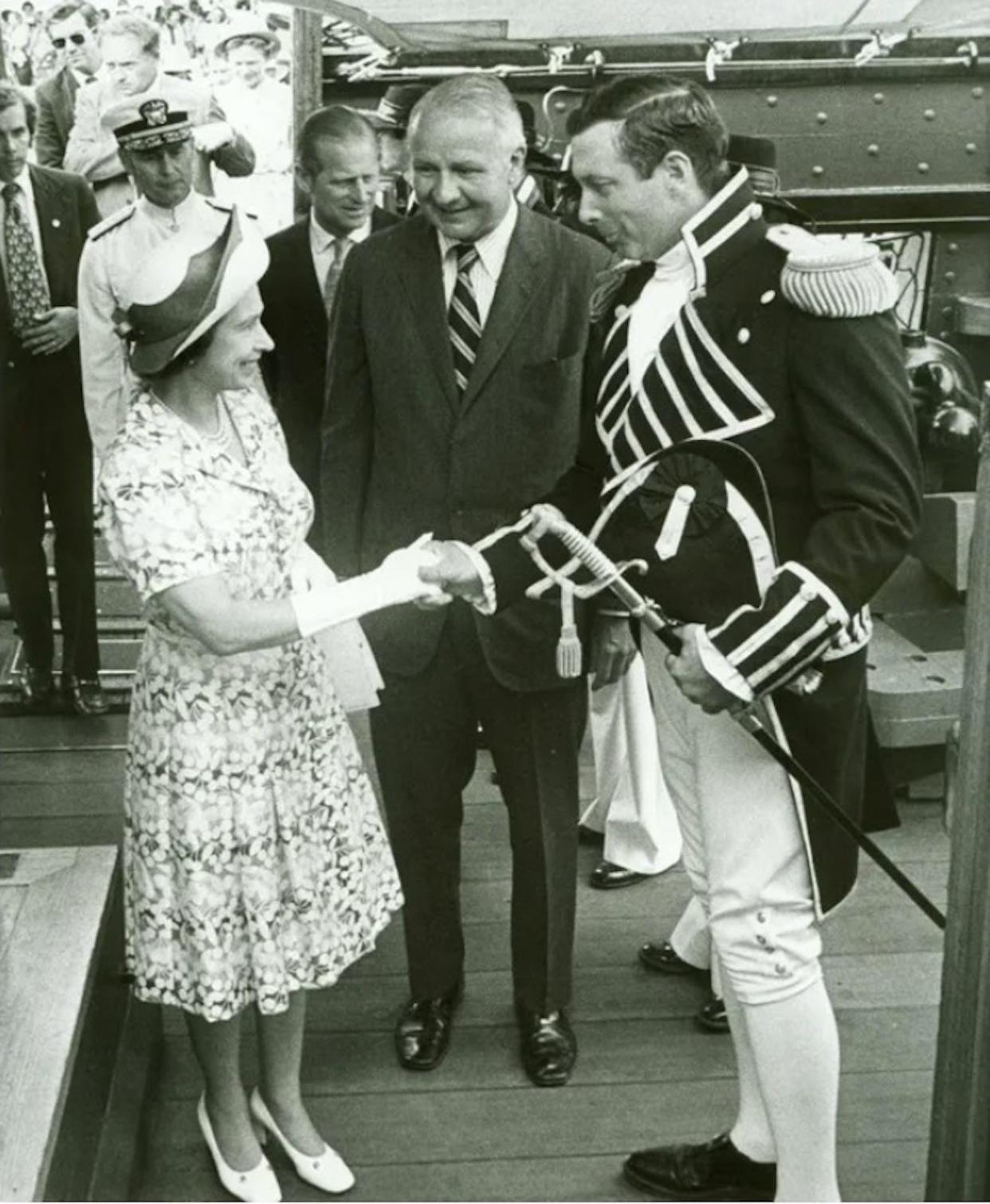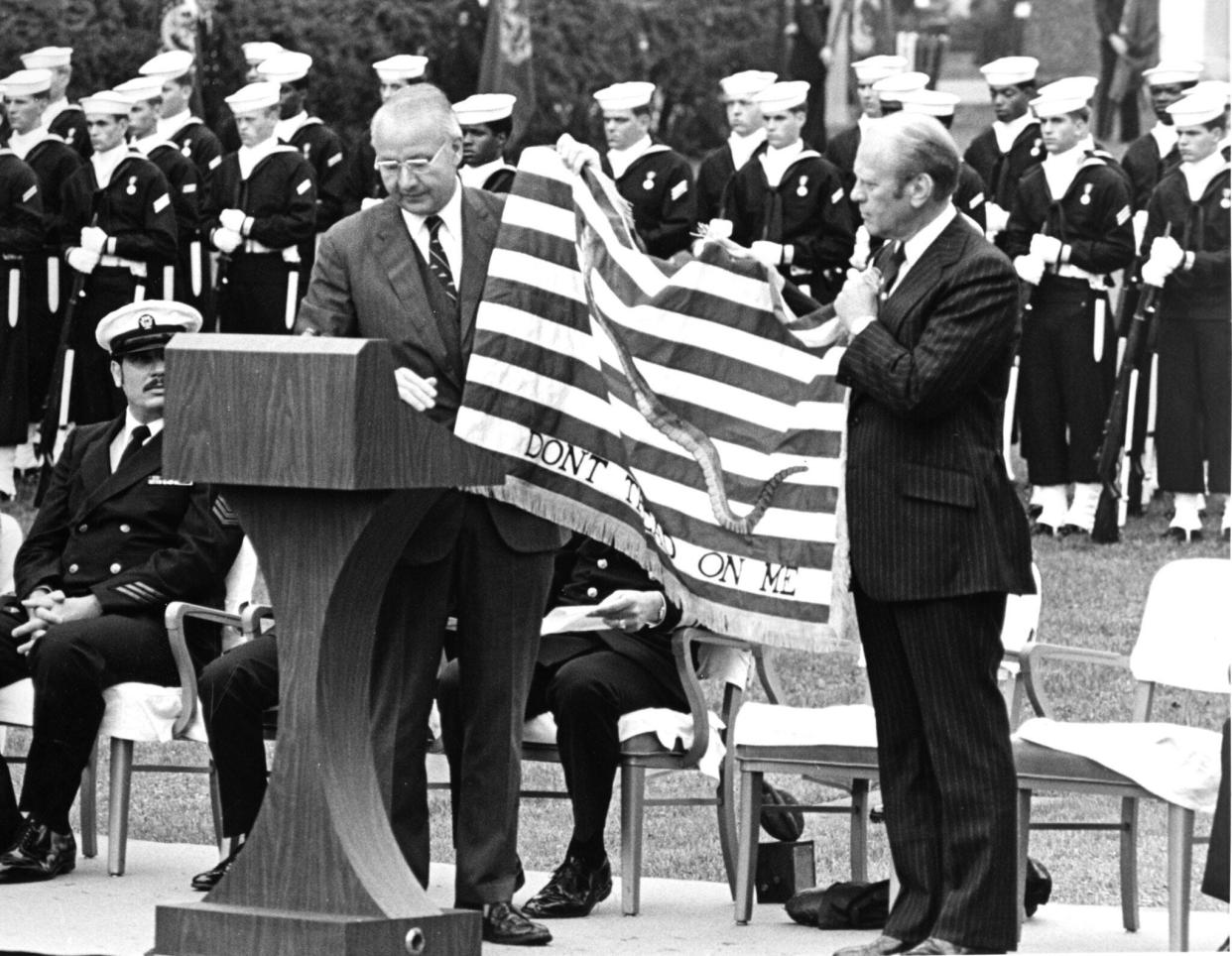Art, politics, and naval dominance: The unparalleled journey of J. William Middendorf
Last week a Naval War College ceremony honored longtime Little Compton resident John William Middendorf II. In June 2022 Secretary of the Navy Carlos Del Toro announced that DDG-138, an Arleigh Burke-class guided-missile destroyer, would be named the USS J. William Middendorf.
Arleigh Burke-class destroyers, built around the Aegis Combat System, are the backbone of the Navy’s surface fleet. DDG-138 is the 88th ship of its class and is a fitting tribute to Middendorf, who championed the Aegis system while he was secretary of the Navy in the mid-1970s.
A true Renaissance man
How many times (usually over cocktails) have we heard someone referred to as a “Renaissance man”?
No one fits that definition more than Bill Middendorf.
In addition to his career in public service, Ambassador Middendorf is a widely respected philanthropist, author, artist and composer.

He also tells me that the New York Giants offered him a baseball tryout in February 1944. He was supposed to report to the famed Mel Ott at the New Yorker Hotel for further instructions. “I was already under contract to the US Navy,” he wrote. “So the New York Giants had to soldier on without me.”
He was born in Baltimore, Maryland, in 1924, and things did not start well. He flunked kindergarten and had to repeat the year. He eventually found his way to Harvard by 1943.
With the war raging, he wanted to become a naval officer. Family links with the Navy ran deep; his direct ancestor was a Baltimore merchant-shipping captain named William Stone. In 1775 Stone donated two of the first eight ships that formed the Continental Navy – the Hornet and the Wasp.
He wrote in his memoir, “Once in V-12 I was eligible for an accelerated wartime version of the Naval Reserve Officer Training Corps (NROTC). These programs granted a degree, and graduates earned a commission.
“So I signed on, but there were no openings at Harvard; I was sent to Holy Cross.” He earned a degree in naval science in 18 months, graduating in 1945. The war was ending, but not his commitment to the Navy.
In the Pacific, he served aboard a Landing Craft Support ship, LCS 53. His ship went up the Yangtze River, where he witnessed the plight of the residents of Shanghai.
He was discharged in August 1946 and returned to Harvard “to complete the degree I began before the war.“
He went on to Wall Street. Working as an investment banker by day and attending classes at the Stern School at New York University at night, earning an MBA in 1954.
In 1963 he partnered with Austen Colgate to form his own firm, Middendorf, Colgate and Company, with a seat on the New York Stock Exchange. Soon he was earning seven figures annually. But something was missing.

“Having learned how to make money,” he wrote, “I wanted to learn how to make a difference.”
He became active in politics, first at the local level and then with the Goldwater presidential campaign in 1964. He became treasurer of the Republican National Committee, funding the very successful elections of 1968.
Shortly after taking office in 1969, President Richard Nixon asked Middendorf what job he wanted.
“I said, secretary of the Navy.”
Nixon replied, ”That's a deal."
“Then he called me back a few weeks later and said, “Would you mind letting John Chafee have the job for now?”
As governor of Rhode Island, Chafee had unexpectedly lost the 1968 election. “He needs a platform from which to run for senator,” Nixon told him. “Let John have it for a year or two and you could take another job in the meantime.”
I said, "All right, make me ambassador to Holland.”
He returned in 1973, served briefly as undersecretary of the Navy, and was told he could expect promotion to secretary.

His nomination stalled. Middendorf learned that Defense Secretary James Schlesinger had a candidate of his own he was pushing. Middendorf called on many of the senators he had supported as RNC treasurer and was quickly nominated and confirmed. As he observed later, “Life is relationships. Politics is compromise.”
Ken Dooley, author and playwright from Lincoln, is Middendorf’s close colleague. Ken, himself 91, co-authored Bill's two books. Ken told me, “Middendorf felt the primary job of SECNAV was to provide the assets the Navy needed to accomplish its mission. That meant getting Congress to approve and fund programs.”
During Middendorf's tenure (1974-1977) he increased the Navy budget by more than 60% while the Army and Air Force budgets remained relatively flat.
“Several dozen congressmen … owed us favors because we had financed their election campaigns. That's why we were able to do what most secretaries aren't able to do. Those were precious assets, and I used them to the fullest.”
Dooley added, “Middendorf was among the premier 'steel benders' – as defense leaders who got things done are called – in helping build some of the most important arms while Navy secretary.”
They include the Ohio-class submarine fleet armed with Trident ballistic missiles. As Middendorf said, “It's what kept Russia honest, because they didn't have this [capability]. … Nobody can take us on because we could wipe out every inch of Russia or China. They are positioned all over the world, almost unreachable by an enemy.”
He also spearheaded development of the Aegis surface-launched missile system. Even today, Aegis cruisers and destroyers constitute most of our warships.

Middendorf is very proud of Aegis. “It’s … the world's best. It’s something I initiated. We designed a destroyer around it called the Arleigh Burke class, and we have more than 80 of those. The ship being named after me is one of them.”
The Reagan years
In 1980, incoming President Ronald Reagan asked Middendorf to head the CIA transition team. He subsequently represented the United States at the Organization of American States (OAS), with the rank of ambassador. He served in the post until 1984, dealing with the Falklands War and the invasion of Grenada.
His last diplomatic assignment was as American representative to the European Community, in which he served until 1987.
Art and music
As much as Middendorf loves the Navy, he also has a passion for the arts. He does not play any instruments (“I can barely tap out a simple tune on a piano!”). However, he is a prolific composer, having produced hundreds of compositions, an opera and nearly a dozen symphonies. He presented the "Holland Symphony" to Queen Juliana of the Netherlands on her 25th anniversary as monarch. Broadcast on Dutch national TV, it received popular acclaim.
Composing music and creating art brought joy and balance to his life. “Art was such great relief from the hard grind of diplomacy and economic and military activities,” he said.
“If it moves, I sketch it,” he added. “I’m still churning out five or six pieces a week [in 2020], even though I’ve now lost most of my eyesight.”
He sketched many of the world leaders he met over the years. “Eisenhower, Nixon, Ford, Reagan, Margaret Thatcher, and pretty much everyone I ran into,” he said.
Starting Dec. 15, the Little Compton Historical Society is mounting an exhibition of his paintings and drawings, he said, adding, “The organizer has picked out 100 images from the thousands I've done over 80 years.”
As a final indicator of his status as Renaissance man, he studied stained-glass artistry. He then joined with Joep Nicolas, the last of the great stained glass artists, to make the last window in Delft cathedral. The window is 80 feet tall.
Calendar
Wednesday, Dec. 20; 7:30-8:30 p.m.; American Legion Post 12 Meeting: Cold Spring Community Center, 30 Beach St. North Kingstown. Email post12@att.net. For more info, contact Stephen Sharkey, (401) 832-6006 or (401) 714-8721.
This article originally appeared on The Providence Journal: USS Middendorf: A tribute to a Renaissance man's naval legacy
